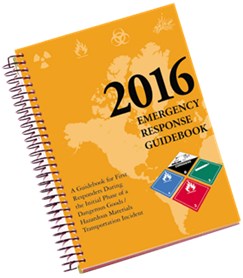Emergency Response Guidebook

Emergency Response Guidebook (ERG) and App First responders refer to this guide as the ERG; it’s a go-to manual to help manage hazardous material incidents for the first 15 minutes to an hour. It’s compiled by DOT/PHMSA and distributed federally to the states to the local jurisdictions. Dan brown movies in order. The guidebook can also be downloaded from Emergency Response Guidebook (ERG). The Department of Homeland Security Information Analysis and Infrastructure Protection (IAIP) Directorate is the central point for notifications regarding infrastructure disruptions and intrusions.
Quickly Identify Hazardous Materials Emergency Procedures PHMSA's 2016 Emergency Response Guidebook provides first responders with a go-to manual to help deal with hazmat transportation accidents during the critical first 30 minutes. DOT's goal is to place an ERG in every public emergency service vehicle nationwide. To date, nearly 14.5 million free copies have been distributed to the emergency response community through state emergency management coordinators.
Members of the public may purchase a copy of the ERG through the GPO Bookstore and other commercial suppliers. First responders, we want your feedback!
Submit your name, organization, contact information, and comments to.
Emergency Response Plan
Authors: Publication Date: Thu May 01 00:00:00 EDT 2008 Research Org.: Sandia National Lab. (SNL-NM), Albuquerque, NM (United States) Sponsoring Org.: USDOE National Nuclear Security Administration (NNSA) OSTI Identifier: 1142963 Report Number(s): SAND2008-3495C 517620 DOE Contract Number: AC04-94AL85000 Resource Type: Conference Resource Relation: Conference: Proposed for presentation at the FBI WMD Coordinators Conference held June 9, 2008 in Albuquerque, NM. Country of Publication: United States Language: English. The US Department of Transportation's 1990 Emergency Response Guidebook will provide an updated Initial Isolation and Protective Action Distances Table guiding first responders during the first 30 minutes of a toxic chemical release from a transportation accident. This paper summarizes the methodology and models used to prepare that table and discusses the major technical issues that were faced in its development. The modeling carried out for the 1990 Table attempted to improve the physics of the source-term release and atmospheric dispersion. Realistic gaseous and liquid accident release scenarios were identified for each of 140 chemicals.
The downwind impact was then computed for releases of each chemical from a variety of appropriate container sizes. Among the submodels used in the source-term and transport modeling were gaseous and liquid release models for the various sizes of containers, pool evaporation models, a flashing model, and an atmospheric dispersion model. A key issue for future study involves the use of the various toxicological guidelines that are presently available for the various chemicals, considering that no single exposure limit has been determined for all chemicals of interest for emergency response planning, and there is no uniform guidance by the toxicologists on the use of the various exposure guidelines in the presence of time-dependent exposures. 10 refs., 2 figs., 2 tabs.
Emergency Response Guidebook Quiz
The Guidebook was developed jointly by Transport Canada (TC), the U.S. Department of Transportation (DOT) and the Secretariat of Communications and Transportation of Mexico (SCT) for use by fire fighters, police, and other emergency services personnel who may be the first to arrive at the scene of a transportation incident involving dangerous goods. It is primarily a guide to aid first responders in quickly identifying the specific or generic hazards of the material(s) involved in the incident, and protecting themselves and the general public during the initial response phase of the incident.
Emergency Response Guidebook Blue Section
This report provides technical documentation for values in the Table of Initial Isolation and Protective Action Distances (PADs) in the '2000 Emergency Response Guidebook' (2000ERG). The objective for choosing the PADs specified in the 2000ERG was to balance the need to adequately protect the public from exposure to potentially harmful substances against the risks and expenses that could result from overreacting to a spill. Beyblade rival game apk. To quantify this balance, a statistical approach was adopted, whereby the best available information was used to conduct an accident scenario analysis and develop a set of up to 100,000 hypothetical incidents. The set accounted for differences in the types of containers, types of incidents, severities of accidents (i.e., amounts released), locations, times of day, times of year, and meteorological conditions involved.
Each scenario was analyzed by using detailed emission rate and atmospheric dispersion models to calculate the downwind chemical concentrations. The safe distance for each incident, defined as the distance downwind from the source at which the chemical concentration falls below the health criteria, was determined. The health criteria used were the American Industrial Hygiene Association's Emergency Response Planning Guideline Level 2 (ERPG-2) or equivalent criteria. The statistical sample of safe distance values for all incidents considered in the analysis was separated into four categories: small spill/daytime release, small spill/nighttime release, large spill/daytime release; and large spill/nighttime release. The 90-percentile safe distance values for each of these groups became the PADs that appear in the 2000ERG table. Fda bcs. This report provides technical documentation for values in the Table of Initial Isolation and Protective Action Distances (PADs) in the 2004 Emergency Response Guidebook (ERG2004).